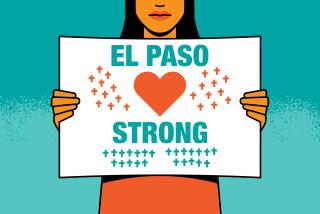Mexico’s City of Promise
- Share via
TIJUANA — Alberto Limon Padilla started with a shabby clapboard store in a working-class neighborhood. He went on to build Tijuana’s first shopping mall and today presides over a business empire.
Aurora Pelayo came to Tijuana a penniless single mother to work in a factory. Today she is secretary-general of the Baja California Democratic Revolutionary Party.
Justina and Rafael Brambila opened a street-side taco stand, La Especial, on Avenida Revolucion when they came from Jalisco in 1948. Today it is a 180-seat restaurant, though the original stand still draws crowds. Their son Alfredo is a successful Tijuana gastroenterologist.
“We came here with nothing, worked night and day, and thanks to God, we prospered,” said Justina Brambila, who will be 90 in March.
“People come from all over Mexico to find work here. Just look at all the ‘help wanted’ signs,” she said. “People bad-mouth Tijuana. They’ve called it Tijuana the Sinner, Tijuana the Pervert. Now they should call it Tijuana the Refuge for Everyone. Because that’s what it has become.”
If the pulsing crisscross of the border is this city’s heartbeat, the legions of immigrants who flow into Tijuana from all over Mexico are its soul. The newcomers lured by the promise of a job and a better life have reinvented this former bawdy backwater into a teeming city of more than a million people where the dream of making it can become a reality.
Its fabled 1% unemployment rate attracts men and women looking to work hard and break free of the barriers to upward mobility that are found in many Mexican cities where land is scarce and those born poor are condemned to die with nothing. Today, only 40% of Tijuana citizens were born here.
“Tijuana is the American dream for Mexicans,” said Nick Inzunza, a member of a family prominent on both sides of the San Diego-Tijuana border. “It means jobs. People come here to work hard and get ahead. It is the land of opportunity.”
Like the American dream, Tijuana’s is something of a myth. It is highly unlikely that a poor Mexican will become a millionaire here, Inzunza added.
“The last time I heard about a poor Mexican Indian who came from Oaxaca and hit the big-time was Benito Juarez, and he’s been dead a hundred years,” Inzunza said, referring to one of Mexico’s most beloved presidents. “Everybody loves that story--’he started with nothing’--but it’s almost never true.”
Success is relative. For the newly arrived, it can mean simply having a job that can feed, clothe and shelter the family. In a country facing its worst economic crisis since the Great Depression, anything beyond that is an achievement.
So in Tijuana, most real-life Horatio Algers are like Juan Jose Espiritu, 23, who came from Guadalajara when he was 13 with his divorced mother and got work cleaning a stained-glass window studio to help support his five younger siblings.
He now earns $480 a month--the salary of many police, teachers, journalists and bank employees--creating Tiffany-style windows with peacocks and ships.
He dreams his good fortune will give his younger siblings educational opportunities he was denied. He says he won’t allow them to quit school to work, as he did.
“Perhaps one of them will become a doctor,” Espiritu said. “That is my desire.”
And on the border, that is something even the most exploited and disenfranchised can hope to wring from the harsh urban sprawl.
Zapotec Indian Maria Gallego, 50, is the illiterate wife of a day laborer in Ensenada who speaks only a few words of Spanish. The oldest of her seven children are a maid and a security guard in Tijuana. But a younger daughter is studying computer programming at the University of Baja California--giving her a shot at the middle class her family could never dream of back in Oaxaca.
Such stories help explain why, in Tijuana, the odds are less stacked against the poor in spite of the acres of shantytowns that cover the city, the skyrocketing violent crime rate, the high drug addiction rate and a system of roads, sanitation and schools woefully overrun by the crush of new arrivals.
Access to land is a big part of what makes Tijuana different from other cities in Mexico.
As late as the 1980s, 40% of Tijuana was built on land with no titles, according to one academic study. Even now, many homes in the shantytowns are built on lands with murky ownership status.
Shantytown dweller Socorro Martinez Silva, 65, arrived from Queretaro a year ago. But she and her daughter, who work as street vendors, are building a house on a plot she purchased with government assistance. “In Queretaro, there are no jobs, and you could never get a piece of land,” Martinez said. “Everything is more difficult.”
Tijuana has a higher percentage of homeowners than more-established Mexican cities, like Guadalajara, according to Jorge Carrillo, a think-tank economist. In Tijuana, as many as half of assembly plant workers are homeowners, Carrillo said.
“People work very hard, because the possibility of succeeding is real. It is not just a dream,” Carrillo said. “People don’t stay in the same job or the same social class. They work to ascend.”
There is also a greater variety of jobs to ascend to.
Only half of Tijuana’s manufacturing jobs are in the lowest-paying maquiladora assembly plants, compared to 90% in Matamoros, Mexico, a Texas border city, Carrillo said. Thirty percent of employment is in the better-paying service sector--an ever-expanding phalanx of hotels, restaurants, bars and businesses linked to the staggering traffic of the world’s busiest border crossing.
Tijuana is the only Mexican border city that has more middle-income than lower-income residents. That means a broader local consumer base for budding entrepreneurs.
Incarnacion Martinez, 23, a Nahuatl-speaking Indian, took a $160-a-month factory job when she and her husband came to Tijuana from a Veracruz village a year ago. They lived in a far-flung shantytown that was an expensive commute from her job.
Now they live downtown and earn $400 a month with his-and-hers vending stands, selling paper flowers, rustic jewelry and other crafts on Avenida Constitucion.
In Tijuana, such street businesses are a way for women and Indians from rural Mexico to avoid sexism and ethnic discrimination in the workplace and still make a decent living. They open diners in the family kitchen, sell tacos in their frontyard or supply homemade tortillas to local restaurants.
Rosa Maria Espinoza Ramirez, 38, found herself in an emotional and financial jam a couple of years ago when her husband walked out on her and three children. But she picked herself up and opened her business in the only space she could--her garage--using the only marketable skill she thought she possessed: good taste.
Today, Mexicans and Americans flock to her quiet street near Tijuana’s famed bullring-by-the-sea to buy the high-quality Mexican ceramics and hacienda-style furniture Espinoza is known for. She earns $500 a month, and hopes to open a store on a busy street, like some of her friends.
Her binational clientele points to what is viewed as Tijuana’s greatest asset: the surging stream of people and cargo that sweep through the border crossing at the city’s front door.
The prosperity brought by that border crossing may be behind what a sociologist terms the “compulsive cosmopolitanism” of Tijuana, its willingness to tolerate and absorb infusions of new people and values.
Its diversity has created a multicultural urban mosaic whose restless charms have invited comparisons to turn-of-the-century Los Angeles and even Las Vegas. In the words of prominent Mexican sociologist Nestor Garcia Canclini, Tijuana is a giant social experiment, a “laboratory of post-modernism.”
Chinese characters on Tijuana tombstones date from the early 1900s, when Asian immigrants sought their “Gold Mountain” south of the border. Later, Russians came to found a religious community near Ensenada. One of modern Tijuana’s most prominent business clans--the Hodoyans--originated with an Armenian who lost his family in the World War I-era massacre.
The city welcomed thousands of the Mexicans forcibly “repatriated” during the Great Depression in the United States--though some were U.S. citizens--and the end of the U.S. bracero work program brought another wave in the 1960s.
Today, many rural Mexican Indians find their way to Tijuana. At least 40 Indian languages are now spoken in Baja California. Indians, typically, are relegated to the bottom rungs of the social ladder.
Unlike most other Latin American urban immigrant magnets, Tijuana was a tiny town when the human tide turned its way--it had barely 13,000 residents in 1933--and there is no strong backbone of old families and traditions.
Those who do move up the social ladder face a noticeable lack of snobbery from Tijuana’s more-established families, a fact that has allowed more than a few drug lords--whose money laundering pumps millions of investment dollars into border economies--to rest comfortably in the bosom of country clubs and business organizations.
“Every city is a social construction, built on the norms of its residents,” said Jose Manuel Valenzuela Arce, a respected Tijuana academic. “Little pieces of Mexico come from all over the country to create the character of Tijuana. Relationships are very face-to-face, without long-standing traditions and families who have known each other for generations.”
New money faces little prejudice. Most of the so-called old money does not date back further than the Prohibition era, when many fortunes were made on gambling, brothels and contraband.
Older Tijuana families do not sequester themselves into ultra-exclusive clubs. And there is little of what Carlos Fuentes’ terms “hidalguia”--the attitude, still common among the Latin American leisure class, that hard work is something that is performed only by social inferiors.
“There is an egalitarian culture here. Even people with a lot of money lack the same pretensions as their counterparts in Mexico City,” said economist Jorge Carrillo. “You go to a restaurant and it’s not always easy to tell who is the employee, the owner or the manager. It is a more just, democratic society.”
Tijuana’s style leaves some feeling stranded and rootless, but there are some notable beneficiaries of the weakness of conventions and traditional tolerance, which is reinforced by its proximity to San Diego.
Gay citizens--shunned in most of homophobic Mexico--have a niche, complete with clubs featuring female impersonators and one of Mexico’s biggest annual gay pride marches.
And ambitious women find themselves less fettered than elsewhere in provincial Mexico, gender experts say.
“This city is far from Mexico’s traditions and its social prejudices: that working women are unfaithful wives, neglectful mothers, selfish, incompetent workers,” said Berenice Ibanez, a respected gender studies researcher at a Tijuana think tank. “Women who come here start working very young. They don’t wait around for someone to come along and transform their life.”
Some experts on the border economy strike a cautionary note, however.
They say that although Tijuana offers more opportunities for the poor than elsewhere in Mexico, many of its industries--most notably, the rapidly growing assembly factories, called maquiladoras--have allowed wages to fall while profits and production rise. In time, that will eventually widen the gap between rich and poor and weaken Tijuana’s consumer base, they say.
“It’s a trickle-up scenario,” said Harley Shaiken, a UC Berkeley professor and economist who is an expert on Mexican labor and the global economy. “The limits to the Tijuana dream are that there are rungs missing on the ladder, though some people climb it anyway.”
*
Next: New female archetype emerges from Tijuana’s economic boom.
More to Read
Sign up for Essential California
The most important California stories and recommendations in your inbox every morning.
You may occasionally receive promotional content from the Los Angeles Times.













